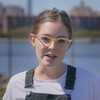Porpentine Charity Heartscape
Porpentine Charity Heartscape and Neotenomie, With Those We Love Alive, 2014. Hypertext. Courtesy the artists
Raúl de Nieves
Installation view of Raúl De Nieves, beginning & the end neither & the otherwise betwixt & between the end is the beginning & the end, 2016. Whitney Biennial 2017, Whitney Museum of American Art, New York, March 13-June 11, 2017. Collection of the artist; courtesy Company Gallery, New York. Photograph by Matthew Carasella.
Leigh Ledare
Aliza Nisenbaum
Aliza Nisenbaum, La Talaverita, Sunday Morning NY Times, 2016. Oil on linen, 68 x 88 in. (172.7 x 223.5 cm). Collection of the artist; courtesy T293 Gallery, Rome and Mary Mary, Glasgow
Pope.L, a.k.a., William Pope.L
Lyle Ashton Harris
Lyle Ashton Harris, Lyle, London, 1992, 2015. Chromogenic print, 20 ½ x 15 in. (52.1 x 38.1 cm). Collection of the artist; courtesy the artist
Anicka Yi
Anicka Yi, still from The Flavor Genome, 2016. 3D high-definition video, color, sound; 22 min. Collection of the artist; courtesy the artist and 47 Canal, New York
Oto Gillen
Cauleen Smith
Installation view of Whitney Biennial 2017 (Floor 5), Whitney Museum of American Art, New York, March 13-June 11, 2017. Photograph by Matthew Carasella.
Installation view of Puppies Puppies, Liberty (Liberté), 2017. Whitney Biennial 2017, Whitney Museum of American Art, New York, March 13-June 11, 2017. Photograph by Matthew Carasella.
